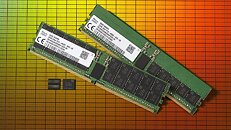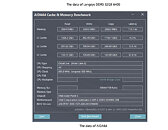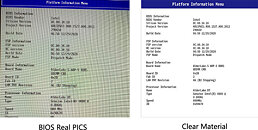Wednesday, March 17th 2021

DDR5-6400 RAM Benchmarked on Intel Alder Lake Platform, Shows Major Improvement Over DDR4
As the industry is preparing for a shift to the new DDR standard, companies are trying to adopt the new technology and many companies are manufacturing the latest DDR5 memory modules. One of them is Shenzhen Longsys Electronics Co. Ltd, a Chinese manufacturer of memory chips, which has today demonstrated the power of DDR5 technology. Starting with this year, client platforms are expected to make a transition to the new standard, with the data center/server platform following. Using Intel's yet unreleased Alder Lake-S client platform, Longsys has been able to test its DDR5 DIMMs running at an amazing 6400 MHz speed and the company got some very interesting results.
Longsys has demoed a DDR5 module with 32 GB capacity, CAS Latency (CL) of 40 CL, operating voltage of 1.1 V, and memory modules clocked at 6400 MHz. With this being an impressive memory module, this is not the peak of DDR5. According to JEDEC specification, DDR5 will come with up to 8400 MHz speeds and capacities that are up to 128 GB per DIMM. Longsys has run some benchmarks, using an 8-core Alder Lake CPU, in AIDA64 and Ludashi. The company then proceeded to compare these results with DDR4-3200 MHz CL22 memory, which Longsys also manufactures. And the results? In AIDA64 tests, the new DDR5 module is faster anywhere from 12-36%, with the only regression seen in latency, where DDR5 is doubling it. In synthetic Ludashi Master Lu benchmark, the new DDR5 was spotted running 112% faster. Of course, these benchmarks, which you can check out here, are provided by the manufacturer, so you must take them with a grain of salt.
Source:
Longsys
Longsys has demoed a DDR5 module with 32 GB capacity, CAS Latency (CL) of 40 CL, operating voltage of 1.1 V, and memory modules clocked at 6400 MHz. With this being an impressive memory module, this is not the peak of DDR5. According to JEDEC specification, DDR5 will come with up to 8400 MHz speeds and capacities that are up to 128 GB per DIMM. Longsys has run some benchmarks, using an 8-core Alder Lake CPU, in AIDA64 and Ludashi. The company then proceeded to compare these results with DDR4-3200 MHz CL22 memory, which Longsys also manufactures. And the results? In AIDA64 tests, the new DDR5 module is faster anywhere from 12-36%, with the only regression seen in latency, where DDR5 is doubling it. In synthetic Ludashi Master Lu benchmark, the new DDR5 was spotted running 112% faster. Of course, these benchmarks, which you can check out here, are provided by the manufacturer, so you must take them with a grain of salt.



49 Comments on DDR5-6400 RAM Benchmarked on Intel Alder Lake Platform, Shows Major Improvement Over DDR4
what kind of garbage DDR4 comes with such a crappy CL for that speed? CL16 is pretty much the norm for that speed on good memory kits.
DDR4 2400 CL15 will be 1/2400*15 = 0.00625
This DDR5 6400 CL40 will be 1/6400*40 = 0.00625
So it is very roughly DDR4 2400 JEDEC performance
Elsewhere the same news is reported with 4800Mhz
4800, with those latency and bandwidth is very different than 6400. ;)
DDR4 has 72-bit channel: 64-bit data + 8-bit ECC.
DDR5 has two 40-bit channels: 32-bit data + 8-bit ECC each.
4800 Mhz @ CL40 is 16,66ns
3200 Mhz CL16 DDR4 is 10,00ns.
3800 CL14 is 7,36ns.
4800 CL18 is 7,91ns.
So intial DDR5 latency will be double that of DDR4. Bit less when compared to standard 3200 CL16 kits.
I also calculated numbers based on speeds we should be getting in the coming years. Assuming the latency does not rise even more:
6400 Mhz CL40 is 12,50ns.
8400 Mhz CL40 is 9,52ns.
So only when DDR5 crosses 8000 Mhz at CL40 does it achieve latency parity with 3200 CL16 but it will still lose to faster DDR4 kits.
So here's hoping that they are no just hoping to brute force performance with raw bandwidth and there are some other things DDR5 does to achieve better latency than a simple Mhz/CL calculation would suggest.That is bevcause thus far the speed increase has been able to offset latency increase. DDR5 will need 8000Mhz to be able to do that. And those speeds are still years away.This was dual channel. As inheritly it would be impossible to run DDR5 on single channel even with just one stick seeing as all DDR5 will have dual channel from a single stick.That's not how memory channels work. You do not get Quad channel simply by using more sticks. Its still dual channel as determined by the motherboard and CPU.DDR5 is unable to run in single channel (unless there is a BIOS option for force disable half the stick) as a single stick will appear to the system as dual channel with all the performance benefits.
But yeah those numbers are atrocious. Dual channel ~30GB/s with 112ns latency. I already get nearly 60GB/s at half that latency on DDR4. As anyone who has experienced DDR generation change - skip the 1st gen. It's not worth it. Only 4800Mhz. DDR4 can already achieve this (with much lower latency). Double or even triple the DDR4 latency and miniscule voltage savings (1.1v vs 1.35v etc).
DDR5 needs to achieve 8000Mhz (at CL40 or lower) to match DDR4-3200 CL16 latency. Preferrably we need something like DDR5-8000 at ~CL30 to establish a clear lead. And you can bet those kits are years away. Not before 2023 or even 2024. Not to mention the early adopter price. I feel like Alder Lake will be great for portable devices (in terms of battery life) with it's big.LITTLE design and lower voltage DDR5 but will offer no benefits on desktop.
Even if they manage to double the bandwidth shown in these pathetic results by Alder Lake's launch it will still match, not exceed DDR4. With triple the system latency to boot. But im sure they will advertise "great savings" in terms of power. A few watts at best considering how little power RAM uses. I feel like DDR5 is aimed at servers first are foremost (low voltage, big capacity etc) and regular desktop users and enthusiasts get shafted once again in the first years.
This will cut these number in half. The memory will burst a 64 bit line and will use the increased memory bandwidth to do it.
This shouldn't help a lot in synthetic benchmark, but it will greatly help for heavily threaded load.
Also, there are many other feature that will increase overall performance but still might not appear in synthetic benchmark. By example, Same bank refresh instead of whole dimm refresh will increase memory availability since only the chip being refresh will be unavailable.
Still, 6400 CL40 is the same as 3200 CL20 and nobody buys CL20 DDR4-3200 any more. It's CL16 for the cheapo-tier mass-market/OEM stuff and CL15/CL14 for the premium bins, meaning that this is a big step backwards over even the cheapest RAM on the market at the moment.
Still, it's only an early demo. Final retail DDR5 should be at least as good as the mainstream stuff when it arrives - in terms of absolute latency, with the added bonus of far more bandwidth (hello, IGP performance!)
This is pure marketing BS, and will end up being the same as every other launch of a memory standard - The new stuff will be marginally worse than the best DDR4, but bandwidth will be better for DDR5. I hope Intel and AMD add some cache to the DDR5 memory controllers, to hide some of that ridiculous latency!
DDR5 like other new generation memory standards are likely to get to servers first and there memory tends to be run at standard speeds.It does make it dual channel but if each channel is now 32-bit instead of 64-bit as with DDR4 the extra channel benefit is largely negated.